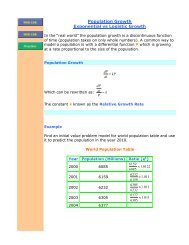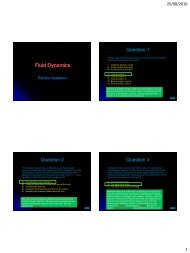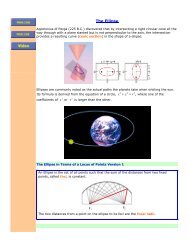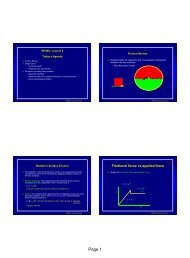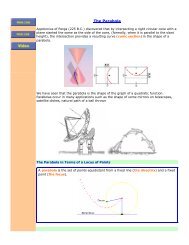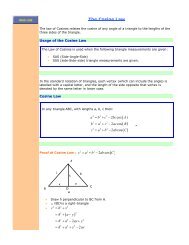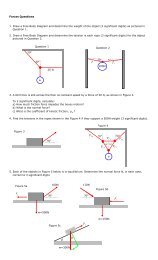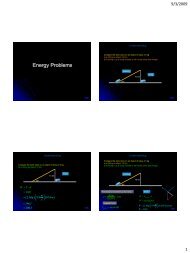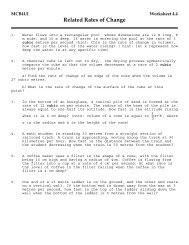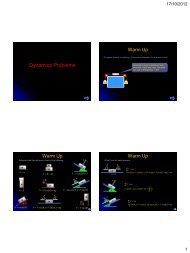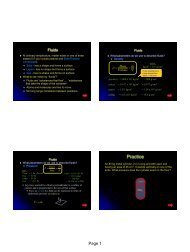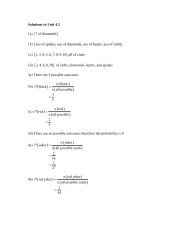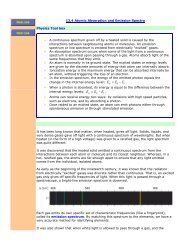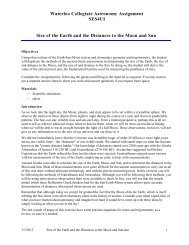Energy Problems - The Burns Home Page
Energy Problems - The Burns Home Page
Energy Problems - The Burns Home Page
- No tags were found...
Create successful ePaper yourself
Turn your PDF publications into a flip-book with our unique Google optimized e-Paper software.
17/11/2010Multiple ChoiceA force F of strength 20N acts on an object of mass 3kg as it moves a distanceof 4m. If F is perpendicular to the 4m displacement, the work done is equal to:<strong>Energy</strong> <strong>Problems</strong>a) 0Jb) 60Jc) 80Jd) 600Je) 2400JSince the Force is perpendicularto the displacement, there is nowork done by this force.Multiple ChoiceMultiple ChoiceUnder the influence of a force, an object of mass 4kg accelerates from 3 m/s to6 m/s in 8s. How much work was done on the object during this time?a) 27Jb) 54Jc) 72Jd) 96Je) Can not be determined from the information givenThis is a job for the work energytheorem.A box of mass m slides down a frictionless inclined plane of length L and verticalheight h. What is the change in gravitational potential energy?a) -mgLb) -mghc) -mgL/hd) -mgh/Le) -mghL<strong>The</strong> length of the ramp is irrelevant,it is only the change in heightW K1 2 2 mvfvi22 21 m m 4 kg 6 32 s s 54J1
17/11/2010Multiple ChoiceMultiple ChoiceAn object of mass m is travelling at constant speed v in a circular path of radiusr. how much work is done by the centripetal force during one-half of arevolution?a) πmv 2 Jb) 2πmv 2 Jc) 0Jd) πmv 2 r Je) 2πmv 2 /r JSince centripetal force always pointsalong a radius towards the centre of thecircle, and the displacement is alwaysalong the path of the circle, no work isdone.While a person lifts a book of mass 2kg from the floor to a tabletop, 1.5m abovethe floor, how much work does the gravitational force do on the book?a) -30Jb) -15Jc) 0Jd) 15Je) 30J<strong>The</strong> gravitational force points downward,while the displacement is upwardW mgh m 2kg9.8 2 1.5m s 30JMultiple ChoiceMultiple ChoiceA block of mass 3.5kg slides down a frictionless inclined plane of length 6m thatmakes an angle of 30 o with the horizontal. If the block is released from rest atthe top of the incline, what is the speed at the bottom?a) 4.9 m/sb) 5.2 m/sc) 6.4 m/sd) 7.7 m/se) 9.2 m/s<strong>The</strong> work done by gravity isequal to the change in Kinetic<strong>Energy</strong>.W K1mgh mv v21 2gh vf2v 2gh2 2f i m 29.8 sin2 306m s m 7.7sA block of mass 3.5kg slides down an inclined plane of length 6m that makes anangle of 60 o with the horizontal. <strong>The</strong> coefficient of kinetic friction between theblock and the incline is 0.3. If the block is released from rest at the top of theincline, what is the speed at the bottom?a) 4.9 m/sb) 5.2 m/sKi Ui W K Uf f fc) 6.4 m/s1 2d) 7.7 m/s0 mgh FfL mvf 02e) 9.2 m/s1 2mg Lsin mg cosL vf2This is a conservation ofMechanical <strong>Energy</strong>, includingthe negative work done byfriction.v f2gLsin cos m 29.8 2 6msin 60 0.3cos60 s m 9.2s2
17/11/2010Multiple ChoiceMultiple ChoiceAn astronaut drops a rock from the top of a crater on the Moon. When the rockis halfway down to the bottom of the crater, its speed is what fraction of its finalimpact speed?a) 1/42b) 1/4c) 1/2 2d) 1/2e) 1/ 2Total energy is conserved. Since the rock has halfof its potential energy, its kinetic energy at thehalfway point is half of its kinetic energy at impact.K v v 2 12A force of 200N is required to keep an object at a constant speed of 2 m/sacross a rough floor. How much power is being expended to maintain thismotion?a) 50Wb) 100Wc) 200Wd) 400We) Cannot be determined with given informationUse the power equationP Fv m 200N2 s 400WUnderstandingUnderstandingCompare the work done on an object of mass 2.0 kga) In lifting an object 10.0mb) Pushing it up a ramp inclined at 30 0 to the same final heightpushinglifting10.0m30 0Compare the work done on an object of mass 2.0 kga) In lifting an object 10.0mW F d mghlifting10.0m30 0m s 2.0kg 9.8 10.0m 2 196J 200J3
17/11/2010UnderstandingCompare the work done on an object of mass 2.0 kga) In lifting an object 10.0mb) Pushing it up a ramp inclined at 30 0 to the same final heightQuestionA 4.0 kg mass is moving to the right at 2.0 m/s. It collides with a 10.0 kgmass sitting still. Given that the collision is perfectly elastic, determinethe final velocities of each of the masses.pushing10.0m30 0<strong>The</strong> distance travelled up the ramp10.0md 20msin30Applied ForceFapplied mg sinWorkW F dappliedW mg sind m W 2.0kg 9.8 sin 3020m2 s W 200J Solutions QuestionA 4.0 kg mass is moving to the right at 2.0 m/s. It collides with a 10.0 kgmass sitting still. Given that the collision is perfectly elastic, determinethe final velocities of each of the masses.QuestionA 4.0 kg mass is moving to the right at 2.0 m/s. It collides with a 10.0 kgmass sitting still. Given that the collision is perfectly elastic, determinethe final velocities of each of the masses.Conservation of Momentump pim v m v m v m v1 1i 2 2 1 1 2 2i f f m 4.0kg 2.0 0 4.0kg v1f 10kg v2 s kg m8.0 4.0kg v1f10kg v2sfffConservation of <strong>Energy</strong>Oh No, weKhave i K2 f1 unknowns.2 1 2If only 1 2 1 2mthere 1v 1i wasm2v another 2i m1v 1 f m2v2 f2 2 2 2equation. 2 m 2 24.0kg 2.0 0 4.0kg v f 10kg v s 2 216.0J 4.0kg v f10kg v1 21 2ffkg m8.0 4.0kg v1 s10kg v216.0J 4.0kg v 10kg v2 2fffkg m8.0 4.0kg v1f10kg v2skg m8.0 10kg v2fv s1 f4. 0kgf1 2 kg m8.0 10kg v2f216.0 4.0 sJ kg 10kg v4. 0kg0 7v8v22 f 20 v2 f 7v2mv2f1.1sff8kg m m8.0 10kg 1.14s s v1f 4. 0kg 0.822f2f4
17/11/2010Example 0SolutionA box slides down an inclined plane (incline angle = 40 0 ). <strong>The</strong> mass of theblock, m, is 35 kg, the coefficient of kinetic friction between the box and theramp, u k , is 0.3, and the length of the ramp, d, is 8m.a) How much work is done by gravity?b) How much work is done by the normal force?c) How much work is done by friction?d) What is the total work done?A box slides down an inclined plane (incline angle = 40 0 ). <strong>The</strong> mass of theblock, m, is 35 kg, the coefficient of kinetic friction between the box and theramp, u k , is 0.3, and the length of the ramp, d, is 8m.a) How much work is done by gravity?Recall Work = force xdistance with theforce being parallelto the distance, thatis, the componentdown the rampWgravity F d mgsin 1760Jdm 2 s 35kg 9.8 sin 408mF gSolutionSolutionA box slides down an inclined plane (incline angle = 40 0 ). <strong>The</strong> mass of theblock, m, is 35 kg, the coefficient of kinetic friction between the box and theramp, u k , is 0.3, and the length of the ramp, d, is 8m.b) How much work is done by the normal force?A box slides down an inclined plane (incline angle = 40 0 ). <strong>The</strong> mass of theblock, m, is 35 kg, the coefficient of kinetic friction between the box and theramp, u k , is 0.3, and the length of the ramp, d, is 8m.c) How much work is done by friction?Since the normal forceis perpendicular to thedisplacement, NOWORK IS DONE.Recall Work = force x distance.W F dfriction u mg cos 0.335kg 9.8 cos408m630Jfkdm 2 s 5
17/11/2010SolutionExample 2A box slides down an inclined plane (incline angle = 40 0 ). <strong>The</strong> mass of theblock, m, is 35 kg, the coefficient of kinetic friction between the box and theramp, u k , is 0.3, and the length of the ramp, d, is 8m.d) What is the total work done?Total Work = sum of all worksA 2.00kg block is pushed against a spring with negligible mass and a forceconstant k=400 N/m, compressing it 0.220 m. when the block is released, itmoves along a frictionless horizontal surface and then up a frictionless inclinewith a slope of 37.0 0 .a) What is the speed of the block as it slides along the horizontal surface afterhaving left the spring?b) How far does the block travel up the incline before starting to slide backdown?W W W Wtotal gravity Normal friction1760J 0J 630J1130JSolution to Example 2A 2.00kg block is pushed against a spring with negligible mass and a force constantk=400 N/m, compressing it 0.220 m. when the block is released, it moves along africtionless horizontal surface and then up a frictionless incline with a slope of 37.0 0 .a) What is the speed of the block as it slides along the horizontal surface after having leftthe spring?b) How far does the block travel up the incline before starting to slide back down?Let’s find the Spring Potential<strong>Energy</strong> first.US1 2 kx21 N 2 400 0.220 m2 m 9.68JWhen released the SpringPotential <strong>Energy</strong> is transferredinto kinetic energy of the Block,where we can solve for v1 2EK mv2129.68J 2.00kg v229.68Jv 2.00kgm 3.11sSolution to Example 1A 2.00kg block is pushed against a spring with negligible mass and a force constantk=400 N/m, compressing it 0.220 m. when the block is released, it moves along africtionless horizontal surface and then up a frictionless incline with a slope of 37.0 0 .a) What is the speed of the block as it slides along the horizontal surface after having leftthe spring?b) How far does the block travel up the incline before starting to slide back down?We can use conservation ofSpring Potential andGravitational Potential <strong>Energy</strong>UG U1 2mgh kx2mgh 9.68Js9.68Jh m 2.00kg9.82 s 0.494mUsing Trig, we will translatethe vertical distance to aramp distance0.494msin 37.0d0.494md sin 37.0 0.821m6
17/11/2010Question 2<strong>The</strong> planet Saturn is moving in the negative x-direction at its orbitalspeed (with respect to the Sun) of 9.6 km/s. <strong>The</strong> mass of Saturn is5.69x10 26 kg. A 2150 kg spacecraft approaches Saturn, moving initiallyin the +x-direction at 10.4 km/s. <strong>The</strong> gravitational attraction of Saturn (aconservative force) causes the spacecraft to swing around it and head ofinto the opposite direction.Determine the speed of the spacecraft after it is far enough away to befree of Saturn’s gravitational pull.Solution to Question 2<strong>The</strong> planet Saturn is moving in the negative x-direction at its orbital speed (with respect to theSun) of 9.6 km/s. <strong>The</strong> mass of Saturn is 5.69x10 26 kg. A 2150 kg spacecraft approachesSaturn, moving initially in the +x-direction at 10.4 km/s. <strong>The</strong> gravitational attraction of Saturn(a conservative force) causes the spacecraft to swing around it and head of into the oppositedirection.Determine the speed of the spacecraft after it is far enough away to be free of Saturn’sgravitational pull.Here the “collision” is not an impact but rather agravitational interaction. So we can treat it as aone-dimensional elastic collision. <strong>The</strong>refore therelative velocities before and after the collisionhave the same magnitude but opposite sign.v v v vpi si pf sfv v v vsf pi si pfkm km km 9.6 10.4 9.6s s s km29.6s<strong>The</strong> reason the spacecraftacquires so much additionalspeed is that Saturn is moving inits orbit. It does slow down, butits mass is so much greater thanthe spacecraft, it is notnoticeable.Question 3You and your bicycle have a combined mass of 80.0kg. When you reachthe base of an bridge, you are traveling along the road at 5.00 m/s. at thetop of the bridge, you have climbed a vertical distance of 5.20m andhave slowed to 1.50 m/s. Ignoring work done by any friction:a) How much work have you done with the force you apply to thepedals?Solution to Question 3You and your bicycle have a combined mass of 80.0kg. When you reach the base of anbridge, you are traveling along the road at 5.00 m/s. at the top of the bridge, you have climbeda vertical distance of 5.20m and have slowed to 1.50 m/s. Ignoring work done by any friction:a) How much work have you done with the force you apply to the pedals?Conservation of energy states that initial kineticenergy equals final kinetic energy plus work doneby gravity less work done by youW ETK Uf K Uif i W K K U Up f i f i1 2 1 2 mvf mvi mgh 02 22 21 m m m 80.0 kg 1.50 5.00 80 kg 9.82 5.2 m2 s s s 3166.8J33.1710J7
17/11/2010Solution to Question 5Cousin Vinney skateboards down a playground ramp. He (25.0 kg) moves through a quartercirclewith radius R=3.00m.a) Determine his speed at the bottom of the rampb) Determine the normal force that acts on him at the bottom of the curve.c) Suppose the ramp is not frictionless and that Vinney’s speed at the bottom is only 6.00m/s. what work was done by the friction force acting on him?<strong>The</strong> normal force does no work, butthe friction force does do work.<strong>The</strong>refore the non-gravitational workdone on Vinney is just the work doneby friction.<strong>The</strong> free body diagram of the normalis through-out his journey is:Question 6A 2000 kg elevator with broken cables is falling at 25 m/s when it firstcontacts a cushioning spring at the bottom of the shaft. <strong>The</strong> spring issupposed to stop the elevator, compressing 3.00 m as it does. Duringthe motion a safety clamp applies a constant 17,000 N frictional force tothe elevator.a) Determine the force constant of the spring.K U W K U1 1 F 2 2W K U K UF2 2 1 11 2 mv2 0 0mgh221 m m 25.0 kg 6.00 25.0 kg 9.802 3.00 m2 s s 285JK 1 +U 1 +W other =K 2 +U 2 5 N1.4110mSolution to Question 6Solution to Question 6A 2000 kg elevator with broken cables is falling at 25 m/s when it first contacts a cushioningA 2000 kg elevator with broken cables is falling at 25 m/s when it first contacts a cushioningspring at the bottom of the shaft. <strong>The</strong> spring is supposed to stop the elevator, compressing3.00 m as it does. During the motion a safety clamp applies a constant 17,000 N frictionalforce to the elevator.spring at the bottom of the shaft. <strong>The</strong> spring is supposed to stop the elevator, compressing3.00 m as it does. During the motion a safety clamp applies a constant 17,000 N frictionalforce to the elevator.a) Determine the force constant of the spring.a) Determine the force constant of the spring.<strong>The</strong> elevator’s initial kinetic energy is:K1 J 625,00021 2 1 mIf we use Point 1 to be the origin, then weK1 mv1 2000 kg 25 625,000 Jhave U2 2 ss =0 and U grav =0, and so U 1 =01 2If we use Point 1 to be the origin, then weU2 mgy2 ky2have U s =0 and U grav =0, and so U 1 =02K U W K U1 1 other 2 2At Point 2, there is both gravitational and1elastic potential energy, but no kinetic625,000J 0J Wother 0J mgy2 kyenergy222 m 2 625,000J 17,000N 3.00m 2000kg 9.80 2 3.00m1s 2U2 mgy2 ky Putting the conservation of energy to work:k 2223.00m9
17/11/2010Example 7An object of mass 1.0 kg travelling at 5.0 m/s enters a region of ice where thecoefficient of kinetic friction is 0.10. Use the Work <strong>Energy</strong> <strong>The</strong>orem to determinethe distance the object travels before coming to a halt.Solution 7An object of mass 1.0 kg travelling at 5.0 m/s enters a region of ice where thecoefficient of kinetic friction is 0.10. Use the Work <strong>Energy</strong> <strong>The</strong>orem to determinethe distance the object travels before coming to a halt.F NForcesWe can see that the objects weight isbalanced by the normal force exerted bythe ice. <strong>The</strong>refore the only work done isdue to the friction acting on the object.Let’s determine the friction force.F f1.0 kgF u Ff k N u mgk0.101.0kg 9.8 m 2 s 0.98NNow apply the work <strong>Energy</strong><strong>The</strong>orem and solve for dW KE1mg2 1 2Ff d mvf mvi2 21 m 1 m0.98N d 1.0kg 0 1.0kg5.02 s 2 s 12.5Jd 0.98N13m2 2AHExample 8A box of mass m is released from rest at point A, the top of a long frictionlessslide. Point A is at height H above the level points B and C. Although the slide isfrictionless, the horizontal surface from point B to C is not. <strong>The</strong> coefficient ofkinetic friction between the box and this surface is u k , and the horizontaldistance between points B and C is x.a) Find the speed of the box when its height above the ground is 1/2Hb) Find the speed of the box when it reaches B.c) Determine the value of u k , so that it comes to a rest at Cd) Determine the value of u k if C was at a height of h above the ground.e) If the slide was not frictionless, determine the work done by friction asthe box moved from A to B if the speed at B was ½ of the speedcalculated in b)AHExample 8A box of mass m is released from rest at point A, the top of a long frictionlessslide. Point A is at height H above the level points B and C. Although the slide isfrictionless, the horizontal surface from point B to C is not. <strong>The</strong> coefficient ofkinetic friction between the box and this surface is u k , and the horizontaldistance between points B and C is x.a) Find the speed of the box when its height above the ground is 1/2HE U K mgH 0 mgHtotalGU K E1 1G2 2total1 1 2 21 2 1mv mgH2 2v gHmg H mv 2mgHu ku kBxCBxC10
17/11/2010AHExample 8A box of mass m is released from rest at point A, the top of a long frictionlessslide. Point A is at height H above the level points B and C. Although the slide isfrictionless, the horizontal surface from point B to C is not. <strong>The</strong> coefficient ofkinetic friction between the box and this surface is u k , and the horizontaldistance between points B and C is x.b) Find the speed of the box when it reaches B.E U K mgH 0 mgHtotalGU K EGB B total120 mv mgH22v 2gHv 2gHAHExample 8A box of mass m is released from rest at point A, the top of a long frictionlessslide. Point A is at height H above the level points B and C. Although the slide isfrictionless, the horizontal surface from point B to C is not. <strong>The</strong> coefficient ofkinetic friction between the box and this surface is u k , and the horizontaldistance between points B and C is x.c) Determine the value of u k , so that it comes to a rest at CW K1 2 1 2W mvf mvi2 21 2 mv i21 2Fd mv i21 2mgukx mvi2v 2viuk2gx2gHHxu ku kBxCBxCAHExample 8A box of mass m is released from rest at point A, the top of a long frictionlessslide. Point A is at height H above the level points B and C. Although the slide isfrictionless, the horizontal surface from point B to C is not. <strong>The</strong> coefficient ofkinetic friction between the box and this surface is u k , and the horizontaldistance between points B and C is x.d) Determine the value of u k if C was at a height of h above the ground.KB UB Wf KC UCmgH 0 F L 0mghBfmgH u mg cosL mghkH u cosL hkLu kxCH hukLcosH hxAHExample 8A box of mass m is released from rest at point A, the top of a long frictionlessslide. Point A is at height H above the level points B and C. Although the slide isfrictionless, the horizontal surface from point B to C is not. <strong>The</strong> coefficient ofkinetic friction between the box and this surface is u k , and the horizontaldistance between points B and C is x.e) If the slide was not frictionless, determine the work done by friction as the boxmoved from A to B if the speed at B was ½ of the speed calculated in b)u kUA KA Wf UB KB1 2UA KAWf mvB21 1mgH 0Wf m 2gH2 2mgHmgH Wf4mgH 3Wf mgH mgH4 4Bx211
17/11/2010Example 9An acrobat swings from the horizontal. When the acrobat was swung an angleof 30 0 , what is his velocity at that point, if the length of the rope is L?Because gravity is aconservative force (thework done by the rope istangent to the motion oftravel), GravitationalPotential <strong>Energy</strong> isconverted to Kinetic<strong>Energy</strong>.U K UI f f1 2mgL mv mgLsin 3021 1 2mgL mv2 22gL vv gL30LIt’s too difficult touse CentripetalAccelerationhLsin 30Example 10A block of mass 3.00 kg sits on a horizontal frictionless surface. It is attached toa spring with a spring constant of 36.0 N / m. <strong>The</strong> weight is pulled 0.16 m awayfrom the equilibrium point and then released.a) Assuming no damping, what is the speed of the block,i) as it passes through the equilibrium point?ii) when it has moved 5.0 cm from its release point?b) Find the time after release that the block first passed through the positionx = 3.0 cm (on the opposite side of its equilibrium point).0.16mExample 10 SolutionA block of mass 3.00 kg sits on a horizontal frictionless surface. It is attached toa spring with a spring constant of 36.0 N / m. <strong>The</strong> weight is pulled 0.16 m awayfrom the equilibrium point and then released.a) Assuming no damping, what is the speed of the block,i) as it passes through the equilibrium point?We can solve this intwo different waysExample 10 SolutionA block of mass 3.00 kg sits on a horizontal frictionless surface. It is attached toa spring with a spring constant of 36.0 N / m. <strong>The</strong> weight is pulled 0.16 m awayfrom the equilibrium point and then released.a) Assuming no damping, what is the speed of the block,i) as it passes through the equilibrium point?We can solve this intwo different ways1) Using Energies1 1kA mv2 22 21 2 1 2kA mv2 2kvAmN36. 0 m 0.160m3.00kgm 0.554s0.16m2) Using Velocity Functionk k v A sintm m We need only the time when the massis at the equilibrium point (ie x=0). Wecan get that by setting the positionfunction = 0 and solving for time or byusing one quarter of the period.¼ of TmT 2k1 23T 4 4 36 1t 4 30.16m36 36 1 v 0.16sin3 3 4 3 360.16 3m 0.554s12
17/11/2010Example 10A block of mass 3.00 kg sits on a horizontal frictionless surface. It is attached toa spring with a spring constant of 36.0 N / m. <strong>The</strong> weight is pulled 0.16 m awayfrom the equilibrium point and then released.a) Assuming no damping, what is the speed of the block,ii) when it has moved 5.0 cm from its release point?Example 10A block of mass 3.00 kg sits on a horizontal frictionless surface. It is attached toa spring with a spring constant of 36.0 N / m. <strong>The</strong> weight is pulled 0.16 m awayfrom the equilibrium point and then released.a) Assuming no damping, what is the speed of the block,ii) when it has moved 5.0 cm from its release point?We can solve this intwo different ways1) Using Energies 5cm1 2 1 2 1 2kx mv kA1 2 1 2 1 2 2 2 216 cmkA mv kx2 2 2k 2 2v A xmx is the position that the spring is stretchedfrom the equilibrium at that at that velocity.This distance is 16cm – 5 cm= 11 cm.N36.02 2 m 0.160 0.1103.00kgm mm 0.40sWe can solve this intwo different ways2) Using Velocity Function 36 5cm0.11 0.16costk k 3 v A sin t16 cmm m 36 cos t 0.68753 36 36 v 0.16 sin 0.2346Setting the position functions to 0.11 m and 36 3 3 1t cos 0.6875solving for time3 0.40m 36t 0.812755sk 3x Acostm t 0.2346 Example 10A block of mass 3.00 kg sits on a horizontal frictionless surface. It is attached toa spring with a spring constant of 36.0 N / m. <strong>The</strong> weight is pulled 0.16 m awayfrom the equilibrium point and then released.b) Find the time after release that the block first passed through the positionx = 3.0 cm (on the opposite side of its equilibrium point).This is a job for theposition function. k x Acostm k x Acostm 36 0.030m 0.160mcost3 cos 12t0.188112t cos 0.188t 0.508s3 cm16 cmExample 14<strong>The</strong> diagram below shows a roller-coaster ride which contains a circular loop ofradius r. A car (mass m) begins from rest from Point A and moves down africtionless ramp to Point B where it enters a vertical loop (frictionless), travellingonce around the circle (B to C to D to E back to B) it then travels along a flat portionfrom B to F (which is not frictionless).a) Find the centripetal acceleration of the car when it is at Point Cb) Determine the speed of the car when its position relative to B is specified by theangle θ shown in the diagram.c) What is the minimum cut-off speed v c that the car must have at D to make itaround the loop?d) What is the minimum height H necessary to ensure that the car makes it aroundthe loop?e) If H=6r and the coefficient of friction between the car and the flat portion of thetrack from B to F is 0.5, how far along the flat portion of the track will the cartravel before coming to rest at F?AHEDθBCF13
17/11/2010HExample 14<strong>The</strong> diagram below shows a roller-coaster ride which contains a circular loop ofradius r. A car (mass m) begins from rest from Point A and moves down africtionless ramp to Point B where it enters a vertical loop (frictionless), travellingonce around the circle (B to C to D to E back to B) it then travels along a flat portionfrom B to F (which is not frictionless).Aa) Find the centripetal acceleration of the car when it is at Point C<strong>The</strong> centripetalacceleration is v 2 /rEDθBCK U K UA A C c1 20 mgH mvC mgr2F2v 2g H rC2v C2g H rr r2g H raCrExample 14<strong>The</strong> diagram below shows a roller-coaster ride which contains a circular loop ofradius r. A car (mass m) begins from rest from Point A and moves down africtionless ramp to Point B where it enters a vertical loop (frictionless), travellingonce around the circle (B to C to D to E back to B) it then travels along a flat portionfrom B to F (which is not frictionless).b) Determine the speed of the car when its position relative to B is specified by theA angle θ shown in the diagram.KAU A K UDH1 20 mgH mv mg r r cos 180 E θ C 2BF1 20 mgH mv mg r r cos 2<strong>The</strong> car’s height above the1 2bottom of the track is given by mg H r 1 cos mvh=r+rcos(180 0 -θ).2 v 2g H r 1cos Example 14<strong>The</strong> diagram below shows a roller-coaster ride which contains a circular loop ofradius r. A car (mass m) begins from rest from Point A and moves down africtionless ramp to Point B where it enters a vertical loop (frictionless), travellingonce around the circle (B to C to D to E back to B) it then travels along a flat portionfrom B to F (which is not frictionless).c) What is the minimum cut-off speed v c that the car must have at D to make itA around the loop?HEDθBCWhen the car reaches D, theforces acting on the car are itsweight, mg, and thedownward Normal Force.<strong>The</strong>se force just match theCentripetal Force with theNormal equalling zero at thecut-off velocity.FvF F FvmC G N2cut offmgr 0rmgmgrExample 14<strong>The</strong> diagram below shows a roller-coaster ride which contains a circular loop ofradius r. A car (mass m) begins from rest from Point A and moves down africtionless ramp to Point B where it enters a vertical loop (frictionless), travellingonce around the circle (B to C to D to E back to B) it then travels along a flat portionfrom B to F (which is not frictionless).d) What is the minimum height H necessary to ensure that the car makes it aroundA the loop?K U K UA A D DHEDApply the cut-off speed from c)to the conservation ofMechanical <strong>Energy</strong>.BC1mgH mv mg r2F20 21mgH m gr mg r2 52 mgr5H r2 214
17/11/2010Example 14<strong>The</strong> diagram below shows a roller-coaster ride which contains a circular loop ofradius r. A car (mass m) begins from rest from Point A and moves down africtionless ramp to Point B where it enters a vertical loop (frictionless), travellingonce around the circle (B to C to D to E back to B) it then travels along a flat portionfrom B to F (which is not frictionless).e) If H=6r and the coefficient of friction between the car and the flat portion of thetrack from B to F is 0.5, how far along the flat portion of the track will the cartravel before coming to rest at F?AKA U A KB UB1 2D 0 mg(6 r) mv B 0H2E CBFCalculate the Kinetic <strong>Energy</strong> atB, then determine how muchwork friction must do toremove this energy.F x 6mgrf mgx k6 mgr6r6rx 12r 0.5k15



